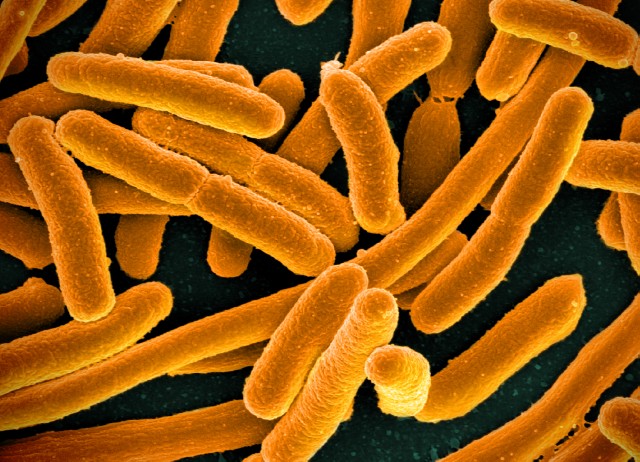
By Ollie Cultrara, Vermont Agency of Agriculture, Food and Markets
What do you think when you hear the phrase “produce safety”? You may have seen headlines about foodborne illness outbreaks, such as the recent outbreaks of E. coli linked to baby spinach or Salmonella linked to onions. Because many fruits and vegetables are commonly eaten raw, we can’t rely on cooking to kill any harmful bacteria, viruses, or parasites that may be hitching a ride on our produce. Here in the Agency’s Produce Program, when we say “produce safety,” we mean protecting fresh fruits and vegetables from becoming contaminated with pathogens that can get people sick.
Pathogens are tricky! They’re too small to see, and contaminated produce won’t necessarily look spoiled. Understanding the pathogens we’re most concerned about—where they come from, the environments they thrive in, and how they spread—is key to preventing contamination from happening in the first place. Let’s look at one category of pathogens that is a culprit in some foodborne illness outbreaks: Escherichia coli (E. coli) bacteria.
What’s at stake
While most of the over 700 species of E. coli bacteria live harmoniously in human or animal guts, certain types of E. coli, like E. coli O157:H7, can make people sick. Symptoms of a pathogenic (disease-causing) E. coli infection can include diarrhea, stomach cramps, fever, nausea, or vomiting. In severe cases, infection can cause life-threatening or chronic conditions. Young children, older adults, and people who are pregnant or immunocompromised are at the highest risk for severe illness or death from foodborne pathogens, but anyone can become sick from contaminated food.
How it spreads
Pathogenic E. coli can live in the intestines and spread through the feces of ruminants, such as cattle, goats, sheep, or deer, as well as humans. Pigs and birds can spread it, too. Soil, water, worker hands or clothing, tools, and other food contact surfaces can all be routes of cross-contamination if they come in contact with feces. Factors to consider when assessing risks of E. coli contamination in fruit and vegetable production include livestock and wildlife activity, adjacent and upstream land uses, manure and compost storage, agricultural water quality, worker hygiene, and sanitation.
E. coli O157:H7 can survive in environments with or without oxygen in temperatures from 45 to 121 degrees Fahrenheit. While these bacteria thrive in warm, damp, and dark environments, they can survive in dust, soil, sediment, or water for weeks or months.
Reducing risks
Farms are open, biodiverse environments where microorganisms are present. While biological risks can’t be eliminated, they can be managed. When it comes to E. coli, it boils down to keeping poop off of produce! Good agricultural practices to reduce the risk of produce becoming contaminated with pathogenic E. coli include:
- Understanding and protecting the quality of water used on produce
- Avoiding harvest of produce with visible animal damage or feces
- Reinforcing good health and hygiene practices, including regular handwashing
- Routinely cleaning, and when appropriate, sanitizing, food contact surfaces
Bacteria need food (like sugars from fruits or vegetables), moisture, and the right temperature range to grow and divide. In the wash/pack area, spaces where water and organic debris collect are important to clean regularly to avoid allowing these "harborage points” to become environments where bacteria can survive and multiply.
Next steps
The Food Safety Modernization Act (FSMA) Produce Safety Rule (PSR) is a federal regulation that aims to prevent foodborne illnesses related to fresh fruits and vegetables. The PSR sets a science-based, national standard for safely growing, harvesting, packing and holding produce on farms. The Rule focuses on microbial contamination risks – conditions that could spread harmful pathogens to produce.
Whether or not your farm is subject to inspection under the PSR, the Vermont Agency of Agriculture’s Produce Program can help you implement practices to protect food safety on your farm. Contact the Vermont Produce Program at AGR.FSMA@vermont.gov, (802) 461-5128. For more information, visit agriculture.vermont.gov/produceprogram.
References
Centers for Disease Control and Prevention. (2014, December 1). E. coli (Escherichia coli) Questions and Answers. Retrieved November 30, 2021, from https://www.cdc.gov/ecoli/general/index.html.
Food and Drug Administration. (2012). Bad Bug Book (second edition). Retrieved November 30, 2021, from https://www.fda.gov/food/foodborne-pathogens/bad-bug-book-second-editio…;
Food and Drug Administration. (2019, March 28). Escherichia coli (E. coli). Retrieved November 30, 2021, from https://www.fda.gov/food/foodborne-pathogens/escherichia-coli-e-coli. &…;
Maine Department of Agriculture, Conservation & Forestry. (n.d.). Escherichia coli O157:H7. Retrieved November 30, 2021, from https://www.maine.gov/dacf/qar/fsma/docs/resourcelibrary/ecoli-o157-h7…;
Produce Safety Alliance. (2019). Module 1: Introduction to Produce Safety. In Produce Safety Alliance Grower Training Course (Version 1.2).
